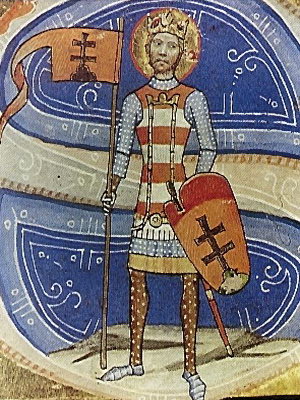Kings in the Calendar

Collect
Grant unto your Church,
we beseech you, Almighty God;
that as she had a zealous champion in blessed Stephen
while he reigned upon earth,
so may she deserve to have him as a glorious protector in heaven.
Through our Lord Jesus Christ, your Son,
who lives and reigns with you in the unity of the Holy Spirit,
God, forever and ever.
Saint Stephen of Hungary and Others
You may have noticed that the calendar in July and August is marked by the memory of no less than three earthly sovereigns, kings! On July 13th we remembered Saint Henry, Emperor and patron of Benedictine Oblates. Today, August 16th, we remember Saint Stephen, King of Hungary. We will remember Saint Louis, King of France on August 25th and on September 28th we will remember Saint Wenceslaus. The procession of holy royalty goes on. There is also the Blessed Emperor Karl of Austria and King of Hungary. Emperor Karl died at the age of thirty-four on April 1st, 1922, praying, “My Jesus! Thy will be done! Jesus!”
With all this royalty in her calendar, is Mother Church hopelessly anachronistic? Some would want to make a clean sweep of the kings and queens in the Catholic calendar. Others judge their presence in the liturgy unacceptable, un-American, an exercise in nostalgia and a concession to diehard right-wing monarchists.
Sons and Fathers of a Catholic Culture
How can we approach this? First of all, we must realize broaden our vision to embrace all of Church history. Secondly, we have to acknowledge the reality of a Catholic Christian culture. The seeds of the Gospel come to maturity in the fruits of a culture marked by the Cross, in treasures of literature, art, music, and architecture and, more humbly, in the customs of ordinary folk, but also in a nation’s legislation, practice of justice, care for the poor, and reverence for the sacred. Thirdly, we have to admit that a Christian king emerges as both the son and the father of such a culture. Henry, Stephen, Louis, Wenceslaus, and Karl were more than crowned figureheads; they were husbands, fathers, and patriots, men of justice, integrity, and compassion.
The Feminization of the Sanctuary
In many parish churches the priest is now the only male in the sacristy and sanctuary. Lectors, cantors, extraordinary ministers of Holy Communion, and servers are, in many places, women and girls. Men and boys seem to have taken flight. The issue is not a new one nor is it exclusively American. I have seen it in Ireland, Italy, and France. In many cultures religion has long been the affair of women interacting, for better or for worse, with a male clergy. Many men are uncomfortable in church. This alone is a compelling reason to keep kings in our calendar.
Christus Rex
The king is an archetype: the symbol of a manhood that is courageous, wise, strong, protecting, nurturing, compassionate and, above all, self-sacrificing. The king holds together in his person the son, the father, the husband, the judge, the warrior, and the provider. This is why we look to the crucified and risen Christ as King. This why little children the world over, even children raised in so-called enlightened democracies, still play at king and queen, still love to heart stories of castles and conquests, of battles, victories, and the triumph of good over evil.
Men Needed
We may think that we no longer need kings . . . but no one can argue that we are not in need of men who are faithful sons of the Church, just citizens, wise leaders, loving husbands and fathers.

It is my understanding that those who want to white-wash the liturgical calendar of saints/blesseds with whom they do not identify (see as “relevant” to their context) because of social status in life or gender or region forget that Christ saved all people, even those who don’t know it. The Catholic Church is most blessed to have characters like Stephen and Henry and others because they remind us of our need to rely on God. James Augustine Aloysius Joyce describes for the composition of the Catholic Church when he says “Here comes everybody.”
We need saints like Stephen, as you point out Dom Mark, because we need models for being “husbands, fathers, and patriots, men of justice, integrity, and compassion.”
It never occurred to me, as an American, to not want royal saints in the Church’s calendar. I always thought it was kind of cool, and not a little amazing, that these persons who “had it all” and were waited on – literally – hand & foot still were models of virtue; especially humility.
Thank you as always, Father Mark, for this extremely edifying meditation.
PAX +
The remark by PAZ is on the money, to use an old phrase.
Yes, THANK YOU Fr. Mark for this wonderful and most edifying meditation and insight.
In Jesus Caritas,
Fr. Yohannes